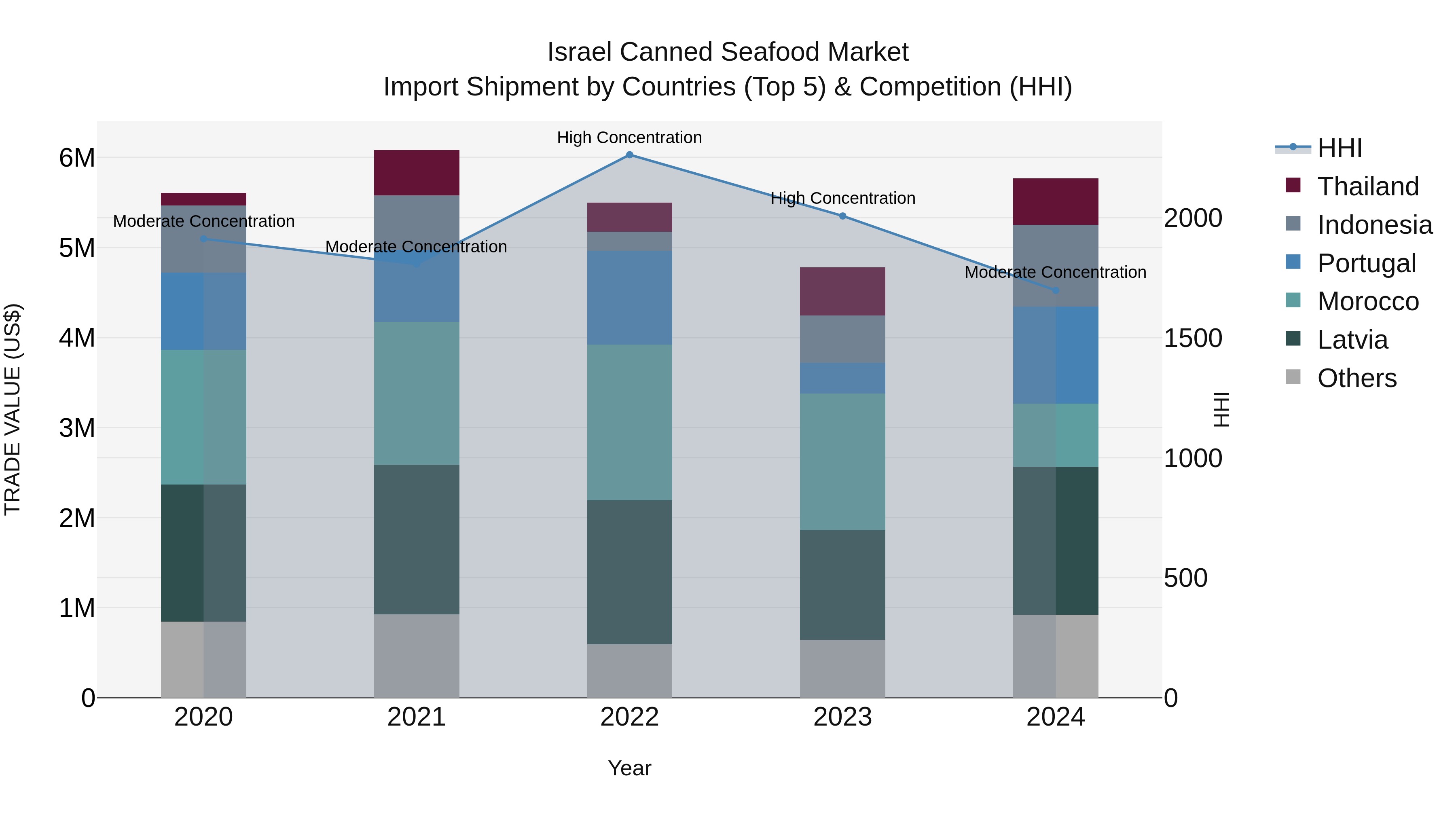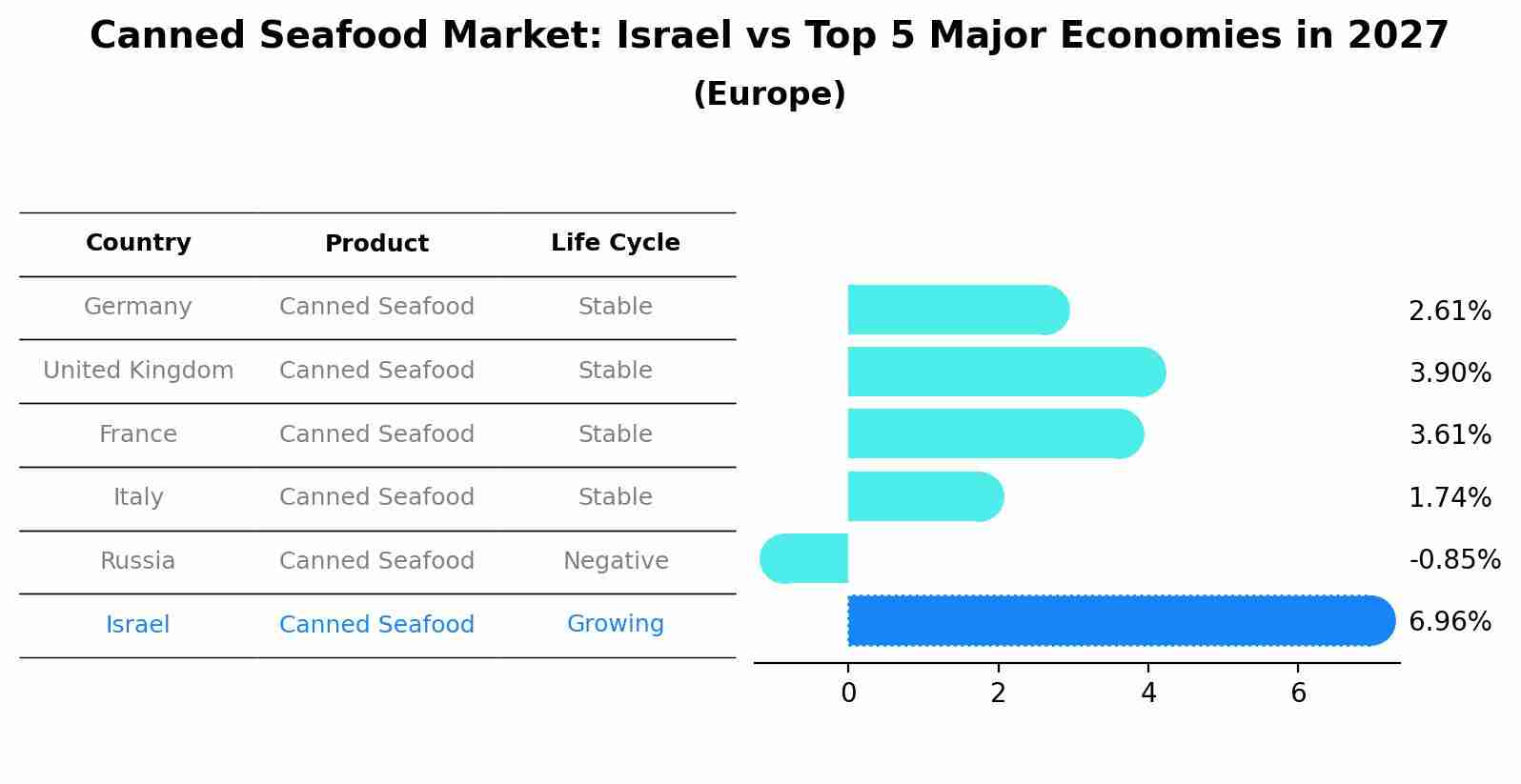Israel Canned Seafood Market (2025-2031) | Growth, Revenue, Analysis, Forecast, Industry, Share, Value, Trends, Segmentation, Outlook, Size & Companies
| Product Code: ETC5170955 | Publication Date: Nov 2023 | Updated Date: Nov 2025 | Product Type: Market Research Report | |
| Publisher: 6Wresearch | Author: Shubham Padhi | No. of Pages: 60 | No. of Figures: 30 | No. of Tables: 5 |
Israel Canned Seafood Market Top 5 Importing Countries and Market Competition (HHI) Analysis
Israel`s canned seafood import market saw a shift in concentration levels from high to moderate in 2024, indicating a more diversified import landscape. The top exporting countries to Israel in 2024 include Latvia, Portugal, Indonesia, Morocco, and Thailand, showcasing a mix of European and Asian suppliers. With a modest Compound Annual Growth Rate (CAGR) of 0.73% from 2020 to 2024 and a notable growth rate of 20.72% from 2023 to 2024, the market is experiencing some positive momentum and potential opportunities for both domestic and international suppliers.

Canned Seafood Market: Israel vs Top 5 Major Economies in 2027 (Europe)
By 2027, the Canned Seafood market in Israel is anticipated to reach a growth rate of 6.96%, as part of an increasingly competitive Europe region, where Germany remains at the forefront, supported by United Kingdom, France, Italy and Russia, driving innovations and market adoption across sectors.

Israel Canned Seafood Market Synopsis
The canned seafood market in Israel reflects the nation`s coastal heritage and culinary preferences. With a rich variety of fish and seafood available in the Mediterranean, canned seafood products enjoy a steady demand. From tuna to sardines, consumers have access to a diverse selection of canned seafood options, both domestically produced and imported.
Drivers of the market
The Israel canned seafood market is driven by factors such as the increasing demand for convenient protein sources, changing dietary preferences, and the growing popularity of seafood-based cuisines. Canned seafood offers an affordable and accessible option for consumers to incorporate seafood into their diets, especially in regions where fresh seafood is not readily available. Additionally, canned seafood products are perceived as healthy and convenient alternatives to fresh or frozen seafood, appealing to health-conscious consumers seeking nutritious meal options. Furthermore, product innovations, such as flavored varieties and sustainable sourcing practices, contribute to the expansion of the Israel canned seafood market.
Challenges of the market
The canned seafood market in Israel confronts challenges related to sustainability, consumer preferences, and competition. With growing concerns about overfishing and environmental conservation, consumers are becoming more selective about the seafood products they purchase, favoring sustainably sourced options. This trend poses a challenge for canned seafood manufacturers, who must ensure the traceability and ethical sourcing of their products to meet consumer expectations. Additionally, competition from fresh and frozen seafood, as well as imported canned seafood brands, further intensifies the challenges faced by local producers. Investing in sustainable fishing practices, certification programs, and marketing initiatives can help Israel canned seafood companies navigate these challenges and maintain their market share.
Government Policy of the market
The Israel Canned Seafood Market is regulated by government agencies overseeing food safety, fisheries, and trade. Regulations address issues such as sustainable fishing practices, seafood processing standards, and labeling requirements. Import regulations may also influence market dynamics by imposing tariffs or quotas on foreign canned seafood products.
Key Highlights of the Report:
- Israel Canned Seafood Market Outlook
- Market Size of Israel Canned Seafood Market, 2024
- Forecast of Israel Canned Seafood Market, 2031
- Historical Data and Forecast of Israel Canned Seafood Revenues & Volume for the Period 2021-2031
- Israel Canned Seafood Market Trend Evolution
- Israel Canned Seafood Market Drivers and Challenges
- Israel Canned Seafood Price Trends
- Israel Canned Seafood Porter`s Five Forces
- Israel Canned Seafood Industry Life Cycle
- Historical Data and Forecast of Israel Canned Seafood Market Revenues & Volume By Product for the Period 2021-2031
- Historical Data and Forecast of Israel Canned Seafood Market Revenues & Volume By Tuna for the Period 2021-2031
- Historical Data and Forecast of Israel Canned Seafood Market Revenues & Volume By Salmon for the Period 2021-2031
- Historical Data and Forecast of Israel Canned Seafood Market Revenues & Volume By Sardines for the Period 2021-2031
- Historical Data and Forecast of Israel Canned Seafood Market Revenues & Volume By Prawns for the Period 2021-2031
- Historical Data and Forecast of Israel Canned Seafood Market Revenues & Volume By Shrimps for the Period 2021-2031
- Historical Data and Forecast of Israel Canned Seafood Market Revenues & Volume By Other Seafood for the Period 2021-2031
- Historical Data and Forecast of Israel Canned Seafood Market Revenues & Volume By Distribution Channel for the Period 2021-2031
- Historical Data and Forecast of Israel Canned Seafood Market Revenues & Volume By Foodservices for the Period 2021-2031
- Historical Data and Forecast of Israel Canned Seafood Market Revenues & Volume By Retail for the Period 2021-2031
- Israel Canned Seafood Import Export Trade Statistics
- Market Opportunity Assessment By Product
- Market Opportunity Assessment By Distribution Channel
- Israel Canned Seafood Top Companies Market Share
- Israel Canned Seafood Competitive Benchmarking By Technical and Operational Parameters
- Israel Canned Seafood Company Profiles
- Israel Canned Seafood Key Strategic Recommendations
Frequently Asked Questions About the Market Study (FAQs):
1 Executive Summary |
2 Introduction |
2.1 Key Highlights of the Report |
2.2 Report Description |
2.3 Market Scope & Segmentation |
2.4 Research Methodology |
2.5 Assumptions |
3 Israel Canned Seafood Market Overview |
3.1 Israel Country Macro Economic Indicators |
3.2 Israel Canned Seafood Market Revenues & Volume, 2021 & 2031F |
3.3 Israel Canned Seafood Market - Industry Life Cycle |
3.4 Israel Canned Seafood Market - Porter's Five Forces |
3.5 Israel Canned Seafood Market Revenues & Volume Share, By Product, 2021 & 2031F |
3.6 Israel Canned Seafood Market Revenues & Volume Share, By Distribution Channel, 2021 & 2031F |
4 Israel Canned Seafood Market Dynamics |
4.1 Impact Analysis |
4.2 Market Drivers |
4.2.1 Increasing health consciousness and preference for convenient, ready-to-eat seafood products |
4.2.2 Growing demand for sustainable and ethically sourced seafood options |
4.2.3 Rise in disposable income leading to higher spending on premium canned seafood products |
4.3 Market Restraints |
4.3.1 Fluctuating raw material prices impacting production costs |
4.3.2 Competition from fresh and frozen seafood products affecting market penetration |
4.3.3 Stringent regulations related to packaging, labeling, and sustainability practices |
5 Israel Canned Seafood Market Trends |
6 Israel Canned Seafood Market Segmentations |
6.1 Israel Canned Seafood Market, By Product |
6.1.1 Overview and Analysis |
6.1.2 Israel Canned Seafood Market Revenues & Volume, By Tuna, 2021-2031F |
6.1.3 Israel Canned Seafood Market Revenues & Volume, By Salmon, 2021-2031F |
6.1.4 Israel Canned Seafood Market Revenues & Volume, By Sardines, 2021-2031F |
6.1.5 Israel Canned Seafood Market Revenues & Volume, By Prawns, 2021-2031F |
6.1.6 Israel Canned Seafood Market Revenues & Volume, By Shrimps, 2021-2031F |
6.1.7 Israel Canned Seafood Market Revenues & Volume, By Other Seafood, 2021-2031F |
6.2 Israel Canned Seafood Market, By Distribution Channel |
6.2.1 Overview and Analysis |
6.2.2 Israel Canned Seafood Market Revenues & Volume, By Foodservices, 2021-2031F |
6.2.3 Israel Canned Seafood Market Revenues & Volume, By Retail, 2021-2031F |
7 Israel Canned Seafood Market Import-Export Trade Statistics |
7.1 Israel Canned Seafood Market Export to Major Countries |
7.2 Israel Canned Seafood Market Imports from Major Countries |
8 Israel Canned Seafood Market Key Performance Indicators |
8.1 Percentage of consumers preferring canned seafood over fresh/frozen options |
8.2 Growth in demand for eco-friendly packaging solutions in the canned seafood market |
8.3 Number of new product launches focusing on innovative flavors and ingredients in the canned seafood segment |
9 Israel Canned Seafood Market - Opportunity Assessment |
9.1 Israel Canned Seafood Market Opportunity Assessment, By Product, 2021 & 2031F |
9.2 Israel Canned Seafood Market Opportunity Assessment, By Distribution Channel, 2021 & 2031F |
10 Israel Canned Seafood Market - Competitive Landscape |
10.1 Israel Canned Seafood Market Revenue Share, By Companies, 2024 |
10.2 Israel Canned Seafood Market Competitive Benchmarking, By Operating and Technical Parameters |
11 Company Profiles |
12 Recommendations | 13 Disclaimer |
- Single User License$ 1,995
- Department License$ 2,400
- Site License$ 3,120
- Global License$ 3,795
Search
Thought Leadership and Analyst Meet
Our Clients
Related Reports
- Afghanistan Apparel Market (2026-2032) | Growth, Outlook, Industry, Segmentation, Forecast, Size, Companies, Trends, Value, Share, Analysis & Revenue
- Canada Oil and Gas Market (2026-2032) | Share, Segmentation, Value, Industry, Trends, Forecast, Analysis, Size & Revenue, Growth, Competitive Landscape, Outlook, Companies
- Germany Breakfast Food Market (2026-2032) | Industry, Share, Growth, Size, Companies, Value, Analysis, Revenue, Trends, Forecast & Outlook
- Australia Briquette Market (2025-2031) | Growth, Size, Revenue, Forecast, Analysis, Trends, Value, Share, Industry & Companies
- Vietnam System Integrator Market (2025-2031) | Size, Companies, Analysis, Industry, Value, Forecast, Growth, Trends, Revenue & Share
- ASEAN and Thailand Brain Health Supplements Market (2025-2031) | Strategy, Consumer Insights, Analysis, Investment Trends, Opportunities, Growth, Size, Share, Industry, Revenue, Segments, Value, Segmentation, Supply, Forecast, Restraints, Outlook, Competition, Drivers, Trends, Demand, Pricing Analysis, Competitive, Strategic Insights, Companies, Challenges
- ASEAN Bearings Market (2025-2031) | Strategy, Consumer Insights, Analysis, Investment Trends, Opportunities, Growth, Size, Share, Industry, Revenue, Segments, Value, Segmentation, Supply, Forecast, Restraints, Outlook, Competition, Drivers, Trends, Demand, Pricing Analysis, Competitive, Strategic Insights, Companies, Challenges
- Europe Flooring Market (2025-2031) | Outlook, Share, Industry, Trends, Forecast, Companies, Revenue, Size, Analysis, Growth & Value
- Saudi Arabia Manlift Market (2025-2031) | Outlook, Size, Growth, Trends, Companies, Industry, Revenue, Value, Share, Forecast & Analysis
- Uganda Excavator, Crane, and Wheel Loaders Market (2025-2031) | Strategy, Consumer Insights, Analysis, Investment Trends, Opportunities, Growth, Size, Share, Industry, Revenue, Segments, Value, Segmentation, Supply, Forecast, Restraints, Outlook, Competition, Drivers, Trends, Demand, Pricing Analysis, Competitive, Strategic Insights, Companies, Challenges
Industry Events and Analyst Meet
Whitepaper
- Middle East & Africa Commercial Security Market Click here to view more.
- Middle East & Africa Fire Safety Systems & Equipment Market Click here to view more.
- GCC Drone Market Click here to view more.
- Middle East Lighting Fixture Market Click here to view more.
- GCC Physical & Perimeter Security Market Click here to view more.
6WResearch In News
- Doha a strategic location for EV manufacturing hub: IPA Qatar
- Demand for luxury TVs surging in the GCC, says Samsung
- Empowering Growth: The Thriving Journey of Bangladesh’s Cable Industry
- Demand for luxury TVs surging in the GCC, says Samsung
- Video call with a traditional healer? Once unthinkable, it’s now common in South Africa
- Intelligent Buildings To Smooth GCC’s Path To Net Zero


















